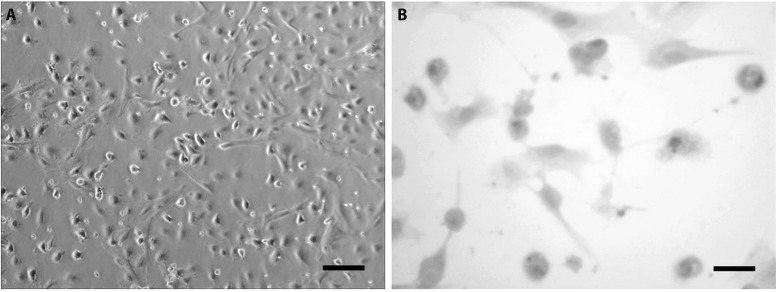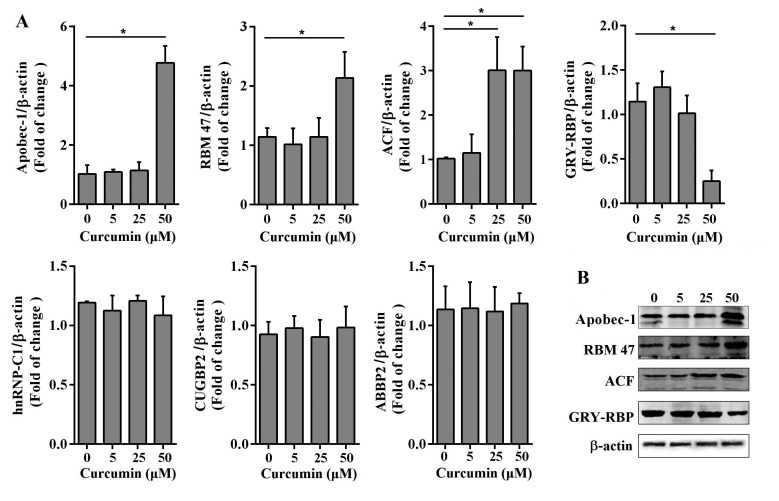Korean J Physiol Pharmacol.
2019 May;23(3):181-189. 10.4196/kjpp.2019.23.3.181.
Curcumin modulates the apolipoprotein B mRNA editing by coordinating the expression of cytidine deamination to uridine editosome components in primary mouse hepatocytes
- Affiliations
-
- 1Institute of Molecular Medicine, Life Science College, Zhejiang Chinese Medical University, Hangzhou 310053, Zhejiang, China. tiannanlux@126.com
- KMID: 2443606
- DOI: http://doi.org/10.4196/kjpp.2019.23.3.181
Abstract
- Curcumin, an active ingredient of Curcuma longa L., can reduce the concentration of low-density lipoproteins in plasma, in different ways. We had first reported that curcumin exhibits hypocholesterolemic properties by improving the apolipoprotein B (apoB) mRNA editing in primary rat hepatocytes. However, the role of curcumin in the regulation of apoB mRNA editing is not clear. Thus, we investigated the effect of curcumin on the expression of multiple editing components of apoB mRNA cytidine deamination to uridine (C-to-U) editosome. Our results demonstrated that treatment with 50 µM curcumin markedly increased the amount of edited apoB mRNA in primary mouse hepatocytes from 5.13%-8.05% to 27.63%-35.61%, and significantly elevated the levels of the core components apoB editing catalytic polypeptide-1 (APOBEC-1), apobec-1 complementation factor (ACF), and RNA-binding-motif-protein-47 (RBM47), as well as suppressed the level of the inhibitory component glycine-arginine-tyrosine-rich RNA binding protein. Moreover, the increased apoB RNA editing by 50 µM curcumin was significantly reduced by siRNA-mediated APOBEC-1, ACF, and RBM47 knockdown. These findings suggest that curcumin modulates apoB mRNA editing by coordinating the multiple editing components of the editosome in primary hepatocytes. Our data provided evidence for curcumin to be used therapeutically to prevent atherosclerosis.
Keyword
MeSH Terms
-
Animals
Apolipoproteins B
Apolipoproteins*
Atherosclerosis
Complement System Proteins
Curcuma
Curcumin*
Cytidine*
Deamination*
Hepatocytes*
Lipoproteins, LDL
Mice*
Plasma
Rats
RNA Editing
RNA, Messenger*
RNA-Binding Proteins
Uridine*
Apolipoproteins
Apolipoproteins B
Complement System Proteins
Curcumin
Cytidine
Lipoproteins, LDL
RNA, Messenger
RNA-Binding Proteins
Uridine
Figure
Reference
-
1. Covello PS, Gray MW. On the evolution of RNA editing. Trends Genet. 1993; 9:265–268. PMID: 8379005.
Article2. Nishikura K. Editor meets silencer: crosstalk between RNA editing and RNA interference. Nat Rev Mol Cell Biol. 2006; 7:919–931. PMID: 17139332.
Article3. Farajollahi S, Maas S. Molecular diversity through RNA editing: a balancing act. Trends Genet. 2010; 26:221–230. PMID: 20395010.
Article4. Qin YR, Qiao JJ, Chan TH, Zhu YH, Li FF, Liu H, Fei J, Li Y, Guan XY, Chen L. Adenosine-to-inosine RNA editing mediated by ADARs in esophageal squamous cell carcinoma. Cancer Res. 2014; 74:840–851. PMID: 24302582.
Article5. Chen L, Li Y, Lin CH, Chan TH, Chow RK, Song Y, Liu M, Yuan YF, Fu L, Kong KL, Qi L, Li Y, Zhang N, Tong AH, Kwong DL, Man K, Lo CM, Lok S, Tenen DG, Guan XY. Recoding RNA editing of AZIN1 predisposes to hepatocellular carcinoma. Nat Med. 2013; 19:209–216. PMID: 23291631.
Article6. Shtrichman R, Germanguz I, Mandel R, Ziskind A, Nahor I, Safran M, Osenberg S, Sherf O, Rechavi G, Itskovitz-Eldor J. Altered A-to-I RNA editing in human embryogenesis. PLoS One. 2012; 7:e41576. PMID: 22859999.
Article7. Hartner JC, Schmittwolf C, Kispert A, Müller AM, Higuchi M, Seeburg PH. Liver disintegration in the mouse embryo caused by deficiency in the RNA-editing enzyme ADAR1. J Biol Chem. 2004; 279:4894–4902. PMID: 14615479.
Article8. Liddicoat BJ, Piskol R, Chalk AM, Ramaswami G, Higuchi M, Hartner JC, Li JB, Seeburg PH, Walkley CR. RNA editing by ADAR1 prevents MDA5 sensing of endogenous dsRNA as nonself. Science. 2015; 349:1115–1120. PMID: 26275108.
Article9. Anant S, Murmu N, Houchen CW, Mukhopadhyay D, Riehl TE, Young SG, Morrison AR, Stenson WF, Davidson NO. Apobec-1 protects intestine from radiation injury through posttranscriptional regulation of cyclooxygenase-2 expression. Gastroenterology. 2004; 127:1139–1149. PMID: 15480992.
Article10. Anant S, Blanc V, Davidson NO. Molecular regulation, evolutionary, and functional adaptations associated with C to U editing of mammalian apolipoproteinB mRNA. Prog Nucleic Acid Res Mol Biol. 2003; 75:1–41. PMID: 14604008.
Article11. Anant S, Davidson NO. Molecular mechanisms of apolipoprotein B mRNA editing. Curr Opin Lipidol. 2001; 12:159–165. PMID: 11264987.
Article12. Pitas RE, Innerarity TL, Mahley RW. Cell surface receptor binding of phospholipid XMLLink_XYZ protein complexes containing different ratios of receptor-active and -inactive E apoprotein. J Biol Chem. 1980; 255:5454–5460. PMID: 7372644.13. Innerarity TL, Mahley RW. Enhanced binding by cultured human fibroblasts of apo-E-containing lipoproteins as compared with low density lipoproteins. Biochemistry. 1978; 17:1440–1447. PMID: 206278.
Article14. Castelli WP, Anderson K, Wilson PW, Levy D. Lipids and risk of coronaryheart disease. The Framingham Study. Ann Epidemiol. 1992; 2:23–28. PMID: 1342260.15. Sandur SK, Ichikawa H, Pandey MK, Kunnumakkara AB, Sung B, SethiG , Aggarwal BB. Role of pro-oxidants and antioxidants in the anti-inflammatory and apoptotic effects of curcumin (diferuloylmethane). Free Radic Biol Med. 2007; 43:568–580. PMID: 17640567.
Article16. Dou X, Fan C, Wo L, Yan J, Qian Y, Wo X. Curcumin up-regulates LDL receptor expression via the sterol regulatory element pathway in HepG2 cells. Planta Med. 2008; 74:1374–1379. PMID: 18704882.
Article17. Peschel D, Koerting R, Nass N. Curcumin induces changes in expression of genes involved in cholesterol homeostasis. J Nutr Biochem. 2007; 18:113–119. PMID: 16713233.
Article18. Liang YF, Zhang DD, Sun LL, Ni L, Liu JX, Wang FF, Fang YC, Wang SQ, Ma XR, Liu L, Wu JM. Research on the effect of Curcumin and Ganoderma lucidum on the expression of ApoB100 mRNA in NAFLD. Heilongjiang Med Pharm. 2013; 36:39–40.19. Tian N, Li X, Luo Y, Han Z, Li Z, Fan C. Curcumin regulates the metabolism of low density lipoproteins by improving the C-to-U RNA editing efficiency of apolipoprotein B in primary rat hepatocytes. Mol Med Rep. 2014; 9:132–136. PMID: 24173373.
Article20. Anant S, Henderson JO, Mukhopadhyay D, Navaratnam N, Kennedy S, Min J, Davidson NO. Novel role for RNA-binding protein CUGBP2 in mammalian RNA editing. CUGBP2 modulates C to U editing of apolipoprotein B mRNA by interacting with apobec-1 and ACF, the apobec-1 complementation factor. J Biol Chem. 2001; 276:47338–47351. PMID: 11577082.21. Fossat N, Tourle K, Radziewic T, Barratt K, Leibhold D, Studdert JB, Power M, Jones V, Loebel DA, Tam PP. C to U RNA editing mediated by APOBEC1 requires RNA-binding protein RBM47. EMBO Rep. 2014; 15:903–910. PMID: 24916387.22. Chen Z, Eggerman TL, Patterson AP. ApoB mRNA editing is mediated by a coordinated modulation of multiple apoB mRNA editing enzyme components. Am J Physiol Gastrointest Liver Physiol. 2007; 292:G53–G65. PMID: 16920700.
Article23. Teng B, Burant CF, Davidson NO. Molecular cloning of an apolipoprotein B messenger RNA editing protein. Science. 1993; 260:1816–1819. PMID: 8511591.
Article24. Lellek H, Kirsten R, Diehl I, Apostel F, Buck F, Greeve J. Purification and molecular cloning of a novel essential component of the apolipoprotein B mRNA editing enzyme-complex. J Biol Chem. 2000; 275:19848–19856. PMID: 10781591.
Article25. Mehta A, Kinter MT, Sherman NE, Driscoll DM. Molecular cloning of apobec-1 complementation factor, a novel RNA-binding protein involved in the editing of apolipoprotein B mRNA. Mol Cell Biol. 2000; 20:1846–1854. PMID: 10669759.
Article26. Fossat N, Tam PP. Re-editing the paradigm of Cytidine (C) to Uridine (U) RNA editing. RNA Biol. 2014; 11:1233–1237. PMID: 25585043.
Article27. Chen Z, Eggerman TL, Bocharov AV, Baranova IN, Vishnyakova TG, Kurlander RJ, Csako G, Patterson AP. Hypermutation of ApoB mRNA by rat APOBEC-1 overexpression mimics APOBEC-3 hypermutation. J Mol Biol. 2012; 418:65–81. PMID: 22326345.
Article28. Chen Z, Eggerman TL, Bocharov AV, Baranova IN, Vishnyakova TG, Csako G, Patterson AP. Hypermutation induced by APOBEC-1 overexpression can be eliminated. RNA. 2010; 16:1040–1052. PMID: 20348446.
Article29. Chen SH, Habib G, Yang CY, Gu ZW, Lee BR, Weng SA, Silberman SR, Cai SJ, Deslypere JP, Rosseneu M, Gotto M, Li WH, Chan L. Apolipoprotein B-48 is the product of a messenger RNA with an organ-specific in-frame stop codon. Science. 1987; 238:363–366. PMID: 3659919.
Article30. Greeve J, Altkemper I, Dieterich JH, Greten H, Windler E. Apolipoprotein B mRNA editing in 12 different mammalian species: hepatic expression is reflected in low concentrations of apoB-containing plasma lipoproteins. J Lipid Res. 1993; 34:1367–1383. PMID: 8409768.
Article31. Powell LM, Wallis SC, Pease RJ, Edwards YH, Knott TJ, Scott J. A novel form of tissue-specific RNA processing produces apolipoprotein-B48 in intestine. Cell. 1987; 50:831–840. PMID: 3621347.
Article32. Chen Z, Eggerman TL, Patterson AP. Phosphorylation is a regulatory mechanism in apolipoprotein B mRNA editing. Biochem J. 2001; 357:661–672. PMID: 11463337.
Article33. Chen Z, Eggerman TL, Potosky D, Arborati M, Patterson AP. Calcium increases apolipoprotein B mRNA editing. Biochem Biophys Res Commun. 2000; 277:221–227. PMID: 11027667.
Article34. Funahashi T, Giannoni F, DePaoli AM, Skarosi SF, Davidson NO. Tissue-specific, developmental and nutritional regulation of the gene encoding the catalytic subunit of the rat apolipoprotein B mRNA editing enzyme: functional role in the modulation of apoB mRNA editing. J Lipid Res. 1995; 36:414–428. PMID: 7775854.
Article35. Giangreco A, Sowden MP, Mikityansky I, Smith HC. Ethanol stimulates apolipoprotein B mRNA editing in the absence of de novo RNA or protein synthesis. Biochem Biophys Res Commun. 2001; 289:1162–1167. PMID: 11741314.
Article36. Lindén D, Sjöberg A, Asp L, Carlsson L, Oscarsson J. Direct effects of growth hormone on production and secretion of apolipoprotein B from rat hepatocytes. Am J Physiol Endocrinol Metab. 2000; 279:E1335–E1346. PMID: 11093922.
Article37. Patterson AP, Chen Z, Rubin DC, Moucadel V, Iovanna JL, Brewer HB Jr, Eggerman TL. Developmental regulation of apolipoprotein B mRNA editing is an autonomous function of small intestine involving homeobox gene Cdx1. J Biol Chem. 2003; 278:7600–7606. PMID: 12493769.
Article38. Wang Y, McLeod RS, Yao Z. Normal activity of microsomal triglyceride transfer protein is required for the oleate-induced secretion of very low density lipoproteins containing apolipoprotein B from McA-RH7777 cells. J Biol Chem. 1997; 272:12272–12278. PMID: 9139669.
Article39. Tai MH, Chen PK, Chen PY, Wu MJ, Ho CT, Yen JH. Curcumin enhances cell-surface LDLR level and promotes LDL uptake through downregulation of PCSK9 gene expression in HepG2 cells. Mol Nutr Food Res. 2014; 58:2133–2145. PMID: 25164566.
Article40. Lu C, Zhang F, Xu W, Wu X, Lian N, Jin H, Chen Q, Chen L, Shao J, Wu L, Lu Y, Zheng S. Curcumin attenuates ethanol-induced hepatic steatosis through modulating Nrf2/FXR signaling in hepatocytes. IUBMB Life. 2015; 67:645–658. PMID: 26305715.
Article41. Panahi Y, Kianpour P, Mohtashami R, Jafari R, Simental-Mendía LE, Sahebkar A. Curcumin lowers serum lipids and uric acid in subjects with nonalcoholic fatty liver disease: a randomized controlled trial. J Cardiovasc Pharmacol. 2016; 68:223–229. PMID: 27124606.
Article42. Neerati P, Devde R, Gangi AK. Evaluation of the effect of curcumin capsules on glyburide therapy in patients with type-2 diabetes mellitus. Phytother Res. 2014; 28:1796–1800. PMID: 25044423.
Article43. Jakstaite A, Maziukiene A, Silkuniene G, Kmieliute K, Dauksa A, Paskauskas S, Gulbinas A, Dambrauskas Z. Upregulation of cugbp2 increases response of pancreatic cancer cells to chemotherapy. Langenbecks Arch Surg. 2016; 401:99–111. PMID: 26691217.
Article44. Subramaniam D, Ramalingam S, Linehan DC, Dieckgraefe BK, Postier RG, Houchen CW, Jensen RA, Anant S. RNA binding protein CUGBP2/CELF2 mediates curcumin-induced mitotic catastrophe of pancreatic cancer cells. PLoS One. 2011; 6:e16958. PMID: 21347286.
Article45. Syng-Ai C, Kumari AL, Khar A. Effect of curcumin on normal and tumor cells: role of glutathione and bcl-2. Mol Cancer Ther. 2004; 3:1101–1108. PMID: 15367704.46. Van Mater D, Sowden MP, Cianci J, Sparks JD, Sparks CE, Ballatori N, Smith HC. Ethanol increases apolipoprotein B mRNA editing in rat primary hepatocytes and McArdle cells. Biochem Biophys Res Commun. 1998; 252:334–339. PMID: 9826530.
Article47. Teng B, Blumenthal S, Forte T, Navaratnam N, Scott J, Gotto AM Jr, Chan L. Adenovirus-mediated gene transfer of rat apolipoprotein B mRNA-editing protein in mice virtually eliminates apolipoprotein B-100 and normal low density lipoprotein production. J Biol Chem. 1994; 269:29395–29404. PMID: 7961918.
Article
- Full Text Links
- Actions
-
Cited
- CITED
-
- Close
- Share
- Similar articles
-
- Differential expression of spinal γ-aminobutyric acid and opioid receptors modulates the analgesic effects of intrathecal curcumin on postoperative/inflammatory pain in rats
- Role of heat shock protein 70 in regulation of anti-inflammatory response to curcumin in 3T3-L1 adipocytes
- Hypocholesterolemic effects of curcumin via up-regulation of cholesterol 7a-hydroxylase in rats fed a high fat diet
- Epidermal Growth Factor Dependent Expression of Plasminogen Activator and Plasminogen Activator Inhibitor in Rat Hepatocytes in Primary Culture
- Successful mouse hepatocyte culture with sandwich collagen gel formation







